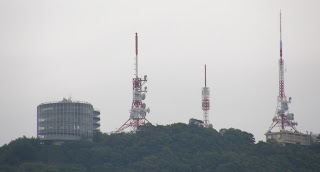Tried
the hotel breakfast again; not a good choice.
But coffee was satisfactory.
Checked out of the hotel at 9:45 and left my suitcases with them. Walked to the airport bus stop to make sure I
knew where it was and then reversed direction and walked to Dejima, built as a
man-made island in the mid-17th century to isolate the local
residents from foreigners and the threat of Christianity they represented. While there have been many changes over the
years, Dejima is still in its original location and maintains its original
fan-like shape. Because it was used for
a variety of purposes over a long span of time, it features both Edo Period
restorations and buildings remaining from the Meiji Period. Restoration and repair work continues to go
on.
I viewed one side of Dejima as I walked from
the hotel. In addition to the map of the
area there was a detailed model.
When there was a need to do restoration, as much as possible original construction techniques were used. However, the sign assured visitors that those techniques were modified in order to take into account current earthquake standards. And, of course, even in “17th century” buildings there need to be accommodations to modern needs.
Dejima is one of the many sites in Japan where visitors can rent kimonos and parade around. This couple was from Taiwan and thoroughly enjoying their dress-up experience.
By
1899 foreigners were not limited to Dejima as they had been in previous
centuries, but the area was still a center of foreign business interests. The International Club was founded by Thomas
Glover (of Glover Gardens fame) and fellow businessmen as a place they could
meet and do business amongst themselves and with their Japanese counterparts.
There
is an emphasis on archaeology and research on the site. Stones from the original bridge leading to
the main gate were preserved and will be used in the construction currently
underway. In the 17th century
the bridge to the main gate, which connected the island with the city, was
guarded by Japanese and posted with a sign on the Edo-machi side of the
bridge. No one other than courtesans and
certain Buddhist priests were allowed onto the island and, of course, no Dutch
were allowed off the island onto the mainland.
The
Chief Factor’s Residence dates from the early 19th century and shows
that living was good for the Dutch East India Company’s first in command.
An
interesting fact that was posted on information boards put up by the Dutch
government which still has strong links to Nagasaki is that from 1810 to 1815
the only place on earth which flew the national flag of The Netherlands was
Dejima. In 1810 France conquered Holland
in the Napoleonic Wars, and England rushed to take over the Dutch Asian
territories. But Blomhoff, a
representative of the Dutch India Trading Post, refused to hand over Dejima to
Lord Raffles. So until the Kingdom of
Netherlands was established in 1815, the Dutch flag flew only in Japan.
As
with most things in Japan there is an emphasis on neatness and cleanliness. Two young women dressed in the official
uniform of the site were going around replacing the dirty mats in the display
buildings with clean ones. I wasn’t sure
the task really needed doing, and they seemed overdressed for the occasion, but
maintaining standards is important.
As
I exited the site, I was drawn to these drains on the ground around the
building. During the Edo period gutters
were installed along both sides of the path to drain water. In the 19th century V-shaped
gutters were installed in the same positions.
The gutters in front of the 10 restored buildings on the site were
recreated in the Edo period style using excavation findings concerning
materials and placement.
One
place I frequently crossed the street (near the YouMe Department Store and its
Food Square) presented a large number of alternatives. The “don’t walk” lasted a long time, but when
“walk” appeared, choices were many.
Walked
the block to my hotel from Dejima, picked up my luggage, and went to the bus stop to catch
the airport limousine which came on time.
Fortunately I had left myself plenty of time because after we had gotten
out of town, had gone through the first tunnel, and were close to the second
tunnel, all traffic was stopped.
According to the pictorial sign which even I could read, there had been
a crash in the tunnel. Police and
emergency vehicles passed us as we turned around (not an easy task with a large
bus) and headed back into Nagasaki City.
Had to drive around the city, with frequent red lights, until we reached
the alternative way out of town to the airport.
Although we were about 45 minutes late, I still had plenty of time to
make the flight to Osaka. Once at Kansai
Airport I had a wait of a couple of hours until the flight to Seoul was ready
for boarding. On this low-cost airline
which charges for everything, the first five rows are more expensive; the first
five rows were empty! I sat in the 6th
so could be the first off the plane in Seoul.
Lines at Passport Control were fairly long but I still made it through
the whole process in time to catch the airport limousine to Apgujong, the area
of the city in which my friend InAe lives.
Her sister, also my good friend, InSook had come out to the airport
to meet me because she was fearful I might miss the last limousine and find the
alternative means of transport too difficult.
We had a pleasant 45-minute ride into the city where she left me at
Building 63, Hyundai Apts., my frequent home in Seoul. It did feel a bit like coming home – although
at midnight I was more ready for bed than appreciating the location.
This blog will continue in Korea.

































